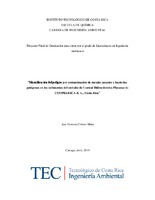| dc.description.abstract | The contamination and potential toxicity of sediments is a yet little explored topic in Costa Rica. On the contrary, the accumulation of sediments in impoundments is a common challenge hydropower plants have. In San Carlos, Costa Rica, the impoundment of Central Hidroeléctrica Platanar (Platanar Hydropower Plant or CHP), has collected waters from Platanar River and Serena Brook for over 20 years; since 2016, the Plant has been managed by COOPELESCA R. L. Platanar River flows through Ciudad Quesada, the city with the highest population density in the district of San Carlos. COOPELESCA R. L. decided to characterize the sediments from the impoundment in order to identify the associated hazards, given that the access restricting signaling in place does not avoid the area from being used as recreational by the locals, and its of interest to the company to correctly dispose the sediments after extractions from its cleaning. For this, a geographic analysis of the contamination influence area of Platanar River and its tributaries was conducted. Two samplings of 7 samples each were directed, for microbiological tests in August and for chemical tests in September 2018. The superficial sediments presented an average pH of 5,9 with a standard deviation of 0,13; a 24,7 % of organic matter and the particle size analysis resulted in (78, 16, 6) % of silt, sand and clay, respectively. The metals As, Hg, Pb, Cd and Cr were quantified and their level of pollution impact and toxicity units were assessed according to international sediment quality guidelines (SQG) from EPA, The Netherlands and Australia. The results showed a moderate impact of heavy metal pollution in the sediments along with the EPA and the mercury level overpassed both the Australian threshold value, and the Dutch background values. Because of this, the possible bioaccumulation and biomagnification of heavy metals in the fauna of the impoundment causes fish consumption to be the main associated risk, using the NTP 330. The Dutch guidelines confirm that the sediments are viable to dispose opencast and in situ remediation is not required. Fecal pollution was found via Escherichia coli in all samples (108 NMP/g sediment, average), considering the sensibility related limitations of this bacteria as an indicator. Salmonella spp. was identified in a 30% of the samples and Listeria monocytogenes could not be identified. At last, recommendations regarding the mitigation of microbiological and heavy metal pollution were given. | es |


